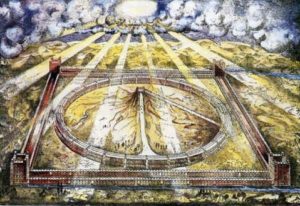One thing that is generally acknowledged by both Hebrews and Christians is that with advent of the coming new Temple in Jerusalem, animal sacrificial worship will be reinstated.
This is believed to take place during the end-times and millennial kingdom time frame.
I touched on this subject a couple of days ago but one of the burning questions that arises whenever this topic comes up is whether or not the reinstatement of the animal sacrifices is a good thing or a bad thing?
Some will argue that it is a bad thing because it is a slap in the face of the grace God has provided through the sacrifice of his son Yeshua.
And others will argue that it’s a good thing because its reinstatement will be a commemoration of Yeshua’s ultimate sacrifice.
Personally, I have to conclude it’s a good thing, because I believe that what God has established in the Torah is HOLY and true and I’m not too confident in the Christian teaching which promotes the idea that Yeshua’s death on the cross was a direct replacement of the Levitical sacrificial system.
I tend to think that Yeshua’s death and the Levitical sacrificial system were two entirely different things with two entirely different objectives.
Yet, I am still studying this issue.
What’s interesting is that when we take a close look at the system established in Torah and compare it with Ezekiel’s vision, we’ll notice some striking differences.
However, we shouldn’t be too surprised about this, because Ezekiel’s vision occurs at the Messiah’s return, hence from a spiritual perspective, there are some huge differences.
Consider this.
Ezekiel’s vision is NOT the first time we witness a shift in details of the sacrificial system.
There are actually some differences in the sacrificial requirements between when God first gave instructions to Moses in Exodus (and a bit in Leviticus) and here in Numbers 28 where we’re at right now.
The instructions concerning the sacrificial system that God gave Moses in Exodus were based on their current wilderness location and Israel’s circumstances BEFORE entering the Promised Land.
However, the instructions we’re dealing with here in Numbers 28 are for AFTER Israel has settled in the Promised Land.
Therefore, the pre-conquest requirements in Exodus and the post-conquest requirements here in Numbers are of course different.
Notices that some of the requirements listed here in Numbers include items such as wine, oxen, and grain that would have been readily available inside the land of Canaan but not so easy to obtain in the wilderness.
Again, my whole point is we shouldn’t be too surprised that Ezekiel’s vision contains some key differences between the instructions given in the Torah.
We’re talking about a totally different time when circumstances will have changed drastically.
So what are some of the differences between the Torah system of Moses and Ezekiel’s vision?
First, one of the biggest differences concerns the daily TAMID (the morning and evening burnt offerings).
Under the Torah system of Moses, it was the Levitical Priesthood who performed the TAMID.
However, in Ezekiel’s vision, it is the worshippers who perform the TAMID.
This is huge and I can’t quite make out the meaning of it.
Also, notice verse 15 of Numbers 28.
“Also a male goat is to be offered as a purification offering to Adonai, in addition to the regular burnt offering and its drink offering.”-Numbers 28:15
According to HASHEM’s instructions here in Numbers, there is to be a Purification Offering or the HATTA-AT in Hebrew to go along with the New Moon celebration as well as on other special occasions.
However, the Purification Offering or the HATTA-AT is conspicuously absent in Ezekiel’s vision!?!!?
Why?
I don’t know man.
There are many more differences and there’s no way I can cover all of them here as the details could fill up a whole book.
I just wanted to bring this to your attention so you are aware that there are differences.
There have been all kinds of reasons given for the discrepancies in detail.
Some scholars will say that the differences are nothing but error and inconsistency.
I can’t buy that because some of the differences are way too significant to be considered just mere error or inconsistency, like the complete absence of the Purification Offering for example.
Other scholars will say that the changes are because under the Torah system of sacrifice, it was the Priest’s job to perform animal sacrifices to obtain atonement for Israel but after Messiah’s sacrifice that is no longer necessary.
Therefore, what we are witnessing in Ezekiel’s vision is as I mentioned earlier simply an ongoing service of commemoration.
Sorry, but I’m not going to be able to come to any clearcut conclusions in this post.
The truth be told, Ezekiel’s vision is as a friend commented to me recently “one of the most confusing portions of the entire Bible“.




Leave a Reply